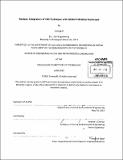| dc.contributor.advisor | Jerome J. Connor. | en_US |
| dc.contributor.author | Ni, Suteng | en_US |
| dc.contributor.other | Massachusetts Institute of Technology. Department of Civil and Environmental Engineering. | en_US |
| dc.date.accessioned | 2013-12-06T20:46:08Z | |
| dc.date.available | 2013-12-06T20:46:08Z | |
| dc.date.copyright | 2013 | en_US |
| dc.date.issued | 2013 | en_US |
| dc.identifier.uri | http://hdl.handle.net/1721.1/82821 | |
| dc.description | Thesis (M. Eng.)--Massachusetts Institute of Technology, Dept. of Civil and Environmental Engineering, 2013. | en_US |
| dc.description | Cataloged from PDF version of thesis. | en_US |
| dc.description | Includes bibliographical references (p. 48-50). | en_US |
| dc.description.abstract | In the last decade, the development of Structural Health Monitoring (SHM) has been skyrocketing because of the serious consequences that come with structural failure. Traditional damage detection techniques, also known as local damage detections, such as visual inspection and ultrasonic testing, have been implemented since the mid 20th century. However, these techniques often require prior knowledge of potential damage locations and require bulky testing equipment. Alternative techniques, the Global Vibration Techniques, were first introduced to analyze the modal information of the structure to assess its overall health state. The drawback of these methods is their insensitivity towards the incipient local damage. With the development of sensor technology, a local damage detection technique, the Electro-Mechanical Impedance (EMI) method, has emerged. EMI measures the electrical admittance by the impedance analyzer, and evaluates the health status of the structure by comparing the baseline signature with the damaged signature. It allows users to access the structure remotely, but it loses its sensitivity when the damage is significant. Therefore, Bhalla, Shanker and Gupta proposed integrating the Global Vibration Techniques with the EMI technique so as to tap on the strengths of the respective techniques. This new method, the Integration of Global Vibration Technique and EMI Technique, draws on EMI's high sensitivity towards early incipient damage and Global Vibration Techniques' sensitivity at late damage stages. The author further examines the integrated method in terms of practicality and scalability. With considerations of some sensor related issues, the author would not suggest to apply the method to real structures. | en_US |
| dc.description.statementofresponsibility | by Suteng Ni. | en_US |
| dc.format.extent | 51 p. | en_US |
| dc.language.iso | eng | en_US |
| dc.publisher | Massachusetts Institute of Technology | en_US |
| dc.rights | M.I.T. theses are protected by
copyright. They may be viewed from this source for any purpose, but
reproduction or distribution in any format is prohibited without written
permission. See provided URL for inquiries about permission. | en_US |
| dc.rights.uri | http://dspace.mit.edu/handle/1721.1/7582 | en_US |
| dc.subject | Civil and Environmental Engineering. | en_US |
| dc.title | Review : integration of EMI technique with global vibration technique | en_US |
| dc.title.alternative | Integration of EMI technique with global vibration technique | en_US |
| dc.title.alternative | Integration of Electro-Mechanical Impedance technique with global vibration technique | en_US |
| dc.type | Thesis | en_US |
| dc.description.degree | M.Eng. | en_US |
| dc.contributor.department | Massachusetts Institute of Technology. Department of Civil and Environmental Engineering | |
| dc.identifier.oclc | 862819788 | en_US |
